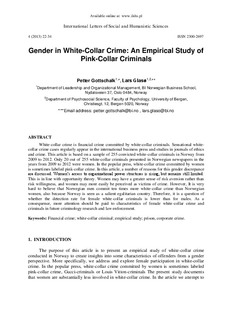Gender in White-Collar Crime: An Empirical Study of Pink-Collar Criminals
Journal article
Permanent lenke
http://hdl.handle.net/11250/93778Utgivelsesdato
2013Metadata
Vis full innførselSamlinger
- Scientific articles [2181]
Sammendrag
White-collar crime is financial crime committed by white-collar criminals. Sensational white-collar crime cases regularly appear in the international business press and studies in journals of ethics and crime. This article is based on a sample of 255 convicted white-collar criminals in Norway from 2009 to 2012. Only 20 out of 255 white-collar criminals presented in Norwegian newspapers in the years from 2009 to 2012 were women. In the popular press, white-collar crime committed by women is sometimes labeled pink-collar crime. In this article, a number of reasons for this gender discrepance are discussed. Women’s access to organizational power structures is rising, but remains still limited. This is in line with opportunity theory. Women may have a greater sense of risk aversion rather than risk willingness, and women may more easily be perceived as victims of crime. However, It is very hard to believe that Norwegian men commit ten times more white-collar crime than Norwegian women, also because Norway is seen as a salient egalitarian country. Therefore, it is a question of whether the detection rate for female white-collar criminals is lower than for males. As a consequence, more attention should be paid to characteristics of female white-collar crime and criminals in future criminology research and law enforcement.
Beskrivelse
This is the originally published version of the article, as published in the journal (Open Access). International Letters of Social and Humanistic Sciences is available online at www.ilshs.pl
